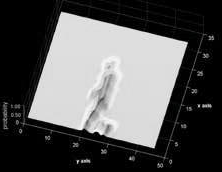
[ My Related Publications ]
+ "Bayesian Modelling of Dynamic Scenes for Object Detection" [ PDF ]
IEEE Transactions on Pattern Analysis and Machine Vision - 2005
+ "Bayesian Object Detection in Dynamic Scenes" [ PDF ]
IEEE International Conference on Computer Vision and Pattern Recognition - 2005
[ Abstract ]
Accurate detection of moving objects is an important precursor to stable tracking or recognition. In this paper, we present an object detection scheme that has three innovations over existing approaches. First, the model of the intensities of image pixels as independent random variables is challenged and it is asserted that useful correlation exists in intensities of spatially proximal pixels. This correlation is exploited to sustain high levels of detection accuracy in the presence of dynamic backgrounds. By using a nonparametric density estimation method over a joint domain-range representation of image pixels, multimodal spatial uncertainties and complex dependencies between the domain (location) and range (color) are directly modeled. We propose a model of the background as a single probability density. Second, temporal persistence is proposed as a detection criterion. Unlike previous approaches to object detection which detect objects by building adaptive models of the background, the foreground is modeled to augment the detection of objects (without explicit tracking) since objects detected in the preceding frame contain substantial evidence for detection in the current frame. Finally, the background and foreground models are used competitively in a MAP-MRF decision framework, stressing spatial context as a condition of detecting interesting objects and the posterior function is maximized efficiently by finding the minimum cut of a capacitated graph. Experimental validation of the proposed method is performed and presented on a diverse set of dynamic scenes.
[ Important Papers on Background Modeling ]
R. Jain and H. Nagel, “On the Analysis of Accumulative Difference Pictures from Image Sequences of Real World Scenes,” IEEE Trans. Pattern Analysis and Machine Intelligence, 1979.
C. Wren, A. Azarbayejani, T. Darrel, and A. Pentland, “Pfinder: Real Time Tracking of the Human Body,” IEEE Trans. Pattern Analysis and Machine Intelligence, 1997.
N. Friedman and S. Russell, “Image Segmentation in Video Sequences: A Probabilistic Approach,” Proc. 13th Conf. Uncertainity in Artificial Intelligence, 1997.
C. Stauffer and W. Grimson, “Learning Patterns of Activity Using Real-Time Tracking,” IEEE Trans. Pattern Analysis and Machine Intelligence, 2000.
A. Elgammal, D. Harwood, and L. Davis, “Background and Foreground Modeling Using Non-Parametric Kernel Density Estimation for Visual Surveillance,” Proceedings of the IEEE, 2002.